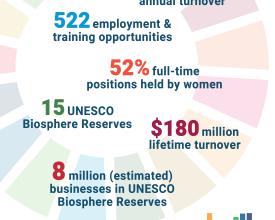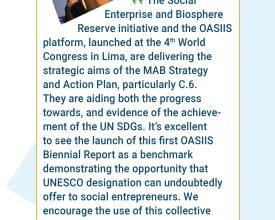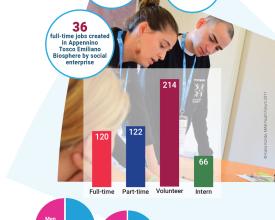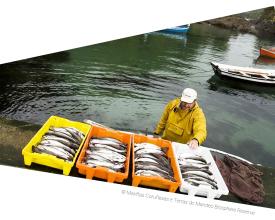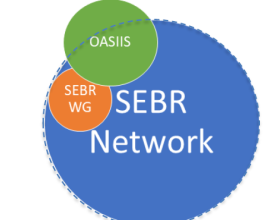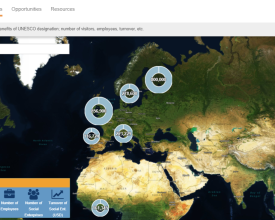OASIIS : Ouvrir l'accès à des sources de revenus indépendantes et durables
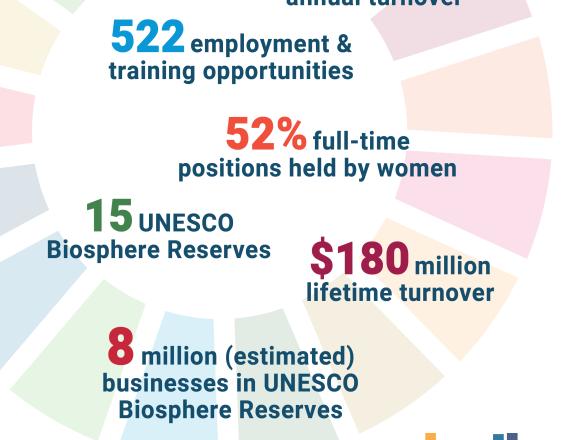
Le capital social est une ressource essentielle et constitue la base de la société, y compris de l'économie. Chez Assist Social Capital (ASC), nous plaçons le capital social au premier plan et appliquons ses principes à la solution de développement durable : OASIIS.
OASIIS est une plateforme en ligne innovante qui vise à promouvoir des économies durables pour la prospérité des personnes et de la planète.
Les entreprises dirigées par des entrepreneurs sociaux ont un énorme potentiel pour susciter des changements positifs dans nos communautés mondiales. Cependant, celles qui ont un impact social et/ou environnemental positif ont du mal à rendre compte de leur impact et à accéder au capital nécessaire pour démarrer, se développer et étendre leurs activités.
En mesurant et en présentant l'empreinte socio-économique des entreprises sociales dans les zones protégées et en mettant en relation les entrepreneurs sociaux entre eux et avec des investisseurs sociaux, nous souhaitons attirer des investissements sociaux dans ces zones et stimuler de nouveaux marchés responsables dans les zones protégées et, par conséquent, la résilience.
Contexte
Défis à relever
Les entreprises dirigées par des entrepreneurs sociaux ont un énorme potentiel pour susciter des changements positifs dans nos communautés mondiales. Cependant, les entreprises qui ont un impact social et/ou environnemental positif, souvent des entreprises sociales, ont du mal à rendre compte de leur impact et à accéder au capital nécessaire pour démarrer, se développer et étendre leurs activités. Les entrepreneurs sociaux sont souvent isolés et n'ont pas accès aux réseaux, aux nouveaux marchés, aux fournisseurs, aux ressources d'apprentissage, à l'apprentissage par les pairs et au dialogue.
L'appétit pour l'investissement d'impact est énorme, avec 35 milliards de dollars investis en 2017, par seulement 225 répondants à l'enquête annuelle du GIIN sur les investisseurs d'impact, 2018. Cependant, les investisseurs sociaux constatent que les entreprises sont souvent difficiles à trouver et que l'impact de leur investissement est souvent difficile à mesurer. Cela est particulièrement vrai lorsqu'il s'agit de PME rurales dans les économies émergentes.
OASIIS vise à combler ces lacunes pour aboutir à des économies durables qui favorisent la prospérité des personnes et de la planète.
Emplacement
Traiter
Résumé du processus
L'approche Social Enterprise and Biosphere Reserve (SEBR) vise à créer un environnement où les entreprises dont les valeurs sont en harmonie avec les buts et objectifs des Réserves de biosphère de l'UNESCO (RB) et d'autres zones protégées peuvent prospérer, en assurant un développement économique durable qui profite à la communauté, investit dans la biodiversité et conduit à des RB financièrement indépendantes.
L'approche SEBR est matérialisée par le réseau SEBR, composé de personnes intéressées par l'approche. Le réseau SEBR au sens large est ensuite soutenu par le groupe de travail du réseau SEBR, qui se réunit tous les trimestres et comprend des représentants et des experts internationaux.
Le réseau SEBR et son groupe de travail soutiennent la coopération entre les RE afin de partager les opportunités et les ressources et de démontrer les avantages socio-économiques de la désignation par l'UNESCO de manière à favoriser les objectifs du plan d'action de Lima et les objectifs de développement durable des Nations unies.
Le réseau SEBR est également soutenu par la plateforme OASIIS - un outil en ligne qui vise à mettre en relation les entrepreneurs sociaux avec les investisseurs sociaux ainsi que toute une série d'autres facilités, y compris les évaluations de l'impact socio-économique. OASIIS est un actif collectif qui partage les valeurs et la vision du programme de l'UNESCO sur l'homme et la biosphère.
Blocs de construction
L'approche : Cadre de développement de l'entreprise sociale et de la réserve de biosphère
Le Cadre de développement de l'entreprise sociale et de la réserve de biosphère (SEBR) peut être appliqué à n'importe quelle zone protégée et vise à fournir un document vivant qui sera flexible et adaptable dans différents pays et contextes, dans le cadre de leurs propres normes, valeurs et approches. En tant que tel, le Cadre est conçu comme une feuille de route vers l'émergence de l'entreprise sociale en tant que moyen de promouvoir le développement économique durable, en harmonie avec la durabilité sociale et environnementale. C'est pourquoi nous avons développé un cadre qui examine l'importance de quatre facteurs clés - la participation publique, l'entreprise sociale, l'investissement social et les marchés publics durables.
Ce cadre peut être utilisé pour tracer le contexte actuel d'une zone protégée, en mettant en évidence les forces et les faiblesses locales par rapport aux quatre facteurs clés. Une fois ce processus de cartographie réalisé, un plan d'action peut être conçu, adapté au pays et au BR. Il est probable qu'il faille environ 3 ans pour créer la dynamique nécessaire pour que cette approche devienne auto-organisée et donc durable à l'avenir.
Facteurs favorables
Le capital social est à la base de l'ensemble du cadre de développement de l'entreprise sociale et de la réserve de biosphère (SEBR-DF). Le capital social détermine la quantité et la qualité de nos interactions sociales et notre capacité à agir collectivement pour résoudre les problèmes de notre vie.
Il s'agit donc d'une ressource essentielle pour toute intervention visant à apporter des avantages durables.
Les quatre facteurs qui sont la clé du succès de SEBR-DF sont les suivants : L'entreprise sociale, l'investissement social, les marchés publics durables et la participation publique.
Leçon apprise
Souvent, le personnel chargé de la gestion des zones protégées possède des compétences essentielles en matière de recherche sur la conservation et lorsqu'il s'agit d'une approche qui inclut le développement économique durable, il peut y avoir des obstacles à l'obtention d'un soutien pour sa mise en œuvre au sein de ces zones.
Assist Social Capital a construit des partenariats solides au sein de la communauté des réserves de biosphère de l'UNESCO depuis qu'il a commencé à travailler dans ce secteur en 2011. Afin d'accélérer ce processus, ASC est co-responsable et secrétaire d'un réseau thématique MAB composé d'experts dans le domaine et se réunissant tous les trimestres pour discuter des progrès et des stratégies visant à mettre l'entrepreneuriat social à l'ordre du jour du MAB.
L'ASC a également influencé le plan d'action international du programme de l'UNESCO sur l'homme et la biosphère, le plan d'action de Lima 2016-2025. Le plan d'action de Lima inclut désormais le soutien et l'inclusion des entrepreneurs sociaux dans les activités des réserves de biosphère de l'UNESCO. Cela a permis à l'ASC d'avoir un mandat officiellement reconnu au sein du programme MAB de l'UNESCO, mais les progrès pour être accepté dans de tels flux de travail sont restés lents.
L'outil : OASIIS - Ouvrir l'accès à des sources de revenus indépendantes et durables
OASIIS est une plateforme en ligne qui rassemble des données sur l'activité socio-économique à l'intérieur et à l'extérieur des zones protégées. En rassemblant des informations dispersées, et souvent informelles, OASIIS permet de démontrer que l'entrepreneuriat social est un moteur du développement durable.
En présentant l'impact socio-économique ainsi que les histoires derrière les organisations, OASIIS vise à canaliser l'investissement social afin d'accélérer et de développer les impacts sociaux, environnementaux et économiques positifs des entreprises dont les valeurs sont en harmonie avec celles des zones protégées.
Facteurs favorables
Le trafic internet mobile représente 51,2 % du trafic mondial en ligne. OASIIS doit être accessible et facile à utiliser, la plateforme est conçue pour être mobile d'abord, afin qu'elle soit inclusive et accessible.
OASIIS sera également un outil modulaire, afin que des outils complémentaires puissent être ajoutés et que des partenariats puissent être intégrés.
Il est donc essentiel qu'OASIIS soit flexible afin de satisfaire les besoins individuels et d'élaborer des études de cas et des récits clairs sur son application, par exemple le premier rapport biennal 2018 d'OASIIS présente de telles études de cas et données.
Leçon apprise
La plateforme actuelle est un produit minimum viable (MVP) et nous développons actuellement une nouvelle itération avec des améliorations basées sur le retour d'information des utilisateurs.
L'engagement avec les utilisateurs et les utilisateurs potentiels a été un processus clé dans le développement.
Nous avons mené un projet pilote dans les réserves de biosphère de l'UNESCO et, après le lancement du premier rapport biennal d'OASIIS, nous avons décidé d'étendre l'approche à d'autres zones protégées et au-delà.
Impacts
Nous avons piloté cette approche dans les réserves de biosphère de l'UNESCO et constaté que 11 millions de dollars circulent dans seulement 2 % des réserves de biosphère de l'UNESCO dans le monde, et que les organisations offrent 522 possibilités d'emploi et de formation et réalisent 395 actions directes pour atteindre les objectifs de développement durable de l'ONU. Ce n'est qu'une infime partie de la contribution des entrepreneurs sociaux aux zones protégées dans le monde.
OASIIS tisse des réseaux, qui sont ensuite utilisés pour exposer les membres d'OASIIS à un nombre accru d'opportunités, tant en termes de financement que de ressources. Par exemple, le Honey Enterprise Cluster hébergé par OASIIS a permis de partager des connaissances entre les producteurs de miel en Italie et les RB ghanéens, et a également demandé un financement de l'UE pour étendre son réseau dans toute la Méditerranée. Les entreprises agroalimentaires du BR de Bia ont été mises en relation avec les marchés et les formations au développement des entreprises par l'intermédiaire d'OASIIS et de partenaires clés. OASIIS accueille What If...Girvan, un programme d'investissement social, et met en place un forum d'investissement OASIIS pour mieux canaliser les financements vers les entreprises sociales à fort impact et prêtes à investir.
OASIIS offre aux investisseurs une plateforme transparente et visible dans le monde entier qui leur permet de localiser les entrepreneurs sociaux et de suivre l'impact de leur investissement.
Ces méthodes sont rarement appliquées aux plateformes d'investissement et d'impact. www.oasiis-br.org
Bénéficiaires
1. Les entrepreneurs sociaux
2. Entreprises sociales (principes sociaux/environnementaux)
3. Investisseurs sociaux
4. Communautés locales (augmentation de l'emploi/des opportunités et des services pour les groupes vulnérables)
5. Gestion des zones protégées
Objectifs de développement durable
Histoire
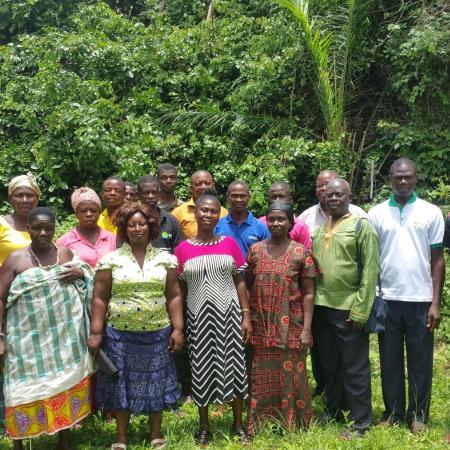
OASIIS vise à mettre les entrepreneurs en contact avec un réseau d'opportunités qui peut prendre de nombreuses formes.
Il peut s'agir de nouvelles connexions, de ressources, de marchés et d'une chance de mesurer et d'apprendre de leur propre empreinte socio-économique, et de voir comment ils s'intègrent dans le contexte de leur zone protégée (ZP) locale ainsi que dans le contexte mondial.
L'un des exemples de cette action a été une série d'événements heureux découlant de nos principes de capital social : plus une personne est véritablement connectée, plus elle est susceptible d'être exposée à des opportunités.
Assist Social Capital CIC a organisé un événement avec des partenaires italiens (Réserve de biosphère Appennino Tosco Emiliano) qui a rassemblé les entrepreneurs sociaux membres d'OASIIS de toute l'Europe. Cet événement a permis à plusieurs entrepreneurs sociaux d'établir des partenariats et de planifier la création de nouveaux produits entre les zones protégées.
Au cours de cet événement et en fonction des besoins des membres d'OASIIS, nous avons créé plusieurs groupes sectoriels d'entreprises, dont le groupe d'entreprises sur le miel. Le Honey Enterprise Cluster unifie les entreprises qui dépendent de manière tangible d'un genre d'importance mondiale et d'écosystèmes sains. La première activité du Honey Enterprise Cluster a été l'échange symbolique de miel entre l'Italie et la Suède et plusieurs activités ont suivi.
L'une d'entre elles est le fruit de notre partenariat avec Challenges Worldwide, avec qui nous avons travaillé pour soutenir les entrepreneurs sociaux de la réserve de biosphère de Bia afin qu'ils acquièrent des compétences commerciales et pénètrent de nouveaux marchés. Nous avons pu mettre en relation un producteur de miel italien, issu d'une entreprise écologique en Italie qui promeut la gestion de l'environnement par le biais de l'agroécologie et du tourisme, avec des producteurs de miel de la réserve de biosphère de Bia au Ghana. Grâce à ce projet, nous avons pu faciliter l'introduction du groupe de producteurs de miel du Ghana auprès d'un acheteur pour l'exportation vers l'Australie. Les réactions à ce projet et les liens établis ont été très positifs et nous espérons faciliter de nombreux autres liens et opportunités.
C'est cette connexion transfrontalière et inclusive qui, associée à l'investissement social pour aider à développer l'approche adoptée par ces entreprises incroyables, peut contribuer à la prospérité des personnes et de la planète.
